Defense Against The Shove
By Stan Hart & Nate Meiers
Image- select one for the sequences to use as a lead
Many martial artists train themselves to be prepared for any situation.
It is ironic, therefore, how many neglect training against the most common
form of attack: The Push.
This article will discuss the push, explain
why it so often occurs and illustrate an effective means of defense
against it. We selected the
push attack for two reasons. First, it is so common. Second, the defenses
used illustrate important concepts such as the use of simultaneous
technique, the art of grabbing or seizing, and targeting vulnerable areas
of the
body. I believe these methods were once integral and taught together
and as such served as fundamental technique and foundation of old Okinawan
karate. Unfortunately, however, this integration of fundamentals has
been lost by successive generations of modern karate-ka.
I use the term “Hakuda” to encompass and encapsulate these
methods into a combined concept illustrated in the two self-defense sequences
shown below. (1)
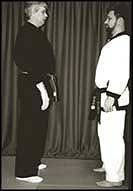 |
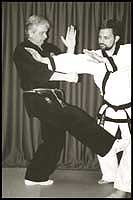 |
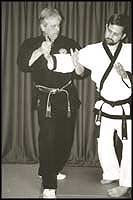 |
Defense against push from close distance |
Cover & ward off push, kick simultaneously |
Grab attackers open hand |
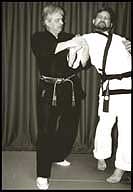 |
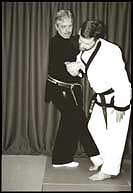 |
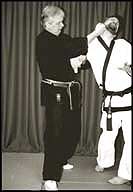 |
Hold open hand with pressure on the wrist |
Maintain pressure on the wrist, if attacker is positioned properly
then attack his shin with your foot and his head with your elbow |
And/or attack with head strike |
Why is the push attack so common? Look at the natural progression of
most confrontations. Many physical attacks do not occur unexpectedly.
There are often at least three stages of confrontation that build upon
each other toward physical aggression.
The initial level, posturing, often begins when someone takes offense
at another’s words or actions. Posturing can also be instigated
when someone feels threatened either physically or socially. Whether
the offense or threat is intended makes no difference in the confrontation.
The actions taken at this stage may include harsh words and an aggressive
physical stance.
If the initial phase is not successfully defused by the martial artist,
the second level of pushing or grabbing is reached. But between a grab
and a push, the push is more common, probably because it is the least
committal of the two attacks. When grabbing the attacker must have his
next step planned; not so with a push. A push can establish superiority
with minimal commitment on the aggressor’s part and it requires
no training or skill.
Often times too, the aggressor is larger and stronger than his victim.
A push uses his strength and weight to his advantage. A push makes the
attacker appear superior by creating the visually impressive effect of
moving the defender across a lot of space. Also, a push makes for an
easy surprise attack, with little physical cues such as making a fist
or winding up to warn the defender.
Unfortunately, however, few are trained in how to defend against the
initial push attack. Reacting incorrectly at this level could prove very
detrimental to the defender. At best the result will be the squaring
off of the two opponents. At worst, without a proper response, a push
can put the victim in a hard-to-defend position such as losing his or
her balance and falling, or being pushed back against a wall or other
object, into a group of others who might be the aggressor’s cohorts,
or further away from an exit.
In this situation the confrontation could quickly escalate to the third,
tertiary level, where the confrontation escalates into punching (where
the aggressor grabs and strikes with hands or feet) or grappling.
But this third level can be avoided. A martial artist can maneuver himself
to an advantageous position if he responds properly. Self-defense training
and kata can prepare us to respond to this secondary level attack, preventing
the escalation to a tertiary level of confrontation. We can prevent the
dangers of a push listed above and even defend ourselves against the
very common situation of multiple attackers.
A second defense against the grab.
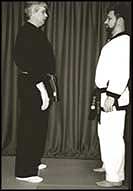 |
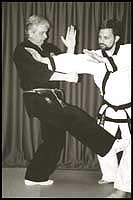 |
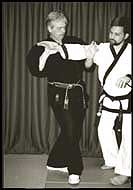 |
Defense against push from close distance
|
Cover & ward off push, kick simultaneously
|
Grab attackers open hand
|
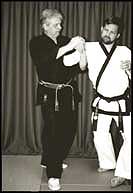 |
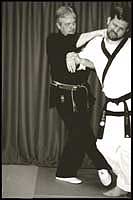 |
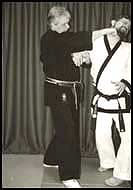 |
Bend wrist down, apply pressure on wrist "gooseneck"
|
Maintain pressure on the wrist, attack his shin
with foot and his head with fist
|
And/or attack with head strike
|
We should note at this point that there are exceptions to this three-stage
building of physical aggression. On occasion a mugger or rapist will
attack with no provocation. Many times, however, a push is the first
stage of attack. Perhaps the aggressor hopes to move the victim to a
strategic (for the attacker) position, or disorient or knock down the
victim. But regardless of whether the martial artist anticipates or is
surprised by the push, if the defender responds with the right method,
the defense will be successful.
It is also worthwhile to understand the psychology behind the push.
What kind of a person pushes another? All people can probably be divided
into three types: passive, assertive and aggressive. The passive person
may be taken advantage of by the other two types.
Instead, the martial artist should be assertive, meaning that he or
she won’t back down when physically attacked and will defend others
when the occasion demands it. The assertive person sets certain boundaries
that when crossed, as in the case of a physical attack like a push, signal
him or her to respond physically to protect the self and the defenseless.
In other words, the martial artist prepares for the aggressive person
who instigates physical aggression and takes advantage of others
Why do aggressive people resort to the push as an attack? (Note that
the push is an attack. It is a threat to the victim’s safety and
grounds for physical response.) Ultimately, the push is intended to place
the attacker in a superior position. If the attacker is among friends,
the push may be used to signal the attacker’s superior “social
position,” an action designed to show that the attacker is superior
(higher in the pecking order).In the case of the unwarranted and unexpected
attack of the mugger or rapist, the intention is to establish a “superior
physical position” as discussed above.
The effective defense in turn is achieved through use of the triad of
combined methods discussed briefly above.
First, the defender employes simultaneous movements to provide superior
technique and application. No untrained and even few trained attackers
are capable of simultaneously using hands and feet in separate offensive
and defensive techniques. The well-trained martial artist will be able
to separate the right and left sides of his body as well as the top (hands)
and bottom (legs), using each quadrant as a distinct weapon during self-defense.
Therefore, while virtually all attackers fight with a 1-2 count, the
experienced practitioner will be able to accomplish three or four techniques
within the time span of his attacker’s 1-2 count, not because he
is necessarily quicker but because he can defend and counter attack simultaneously.
The concept of simultaneous technique is not new. In karate many early
photos of Chojun Miyagi, Choki Motobu and other karate pioneers illustrate
the use of feet and hands at the same time. Wing Chun and many other
Chinese martial arts also employ this principle.
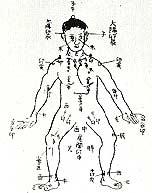 |
This illustration taken from the Bubishi illustrates various
dangerous points on the human body that can be attacked. |
The second leg of the combined concept in these defenses is an old sub-specialty
of karate -- the art of kicking and hitting “forbidden places,” or
Kinsho-Jitsu (2) This is a hot topic of discussion in martial arts today
with various theories and teachers. Many believe that that this art has
been hidden within karate kata and represents an important sub-specialty
of martial arts. It is also found within the once secret book known as
the Bubishi. It was the prized possession of many early Okinawan karate
pioneers and faithfully copied by their most trusted students. But, knowledge
of where and how to hit an opponent is not enough. It must be buttressed
with other technique.
The third leg of the combined concept of self-defense illustrated is
also an old sub-specialty of karate-- the art of gripping and grabbing,
which I call, Hakushu. (3) Many teachers
and historians believe that these techniques were once integral to the
original Okinawan defensive
art of “te,” (meaning “hand”), but now remain
largely hidden within karate kata. The Chinese arts sometimes refer to
this as Chin na. (4)
When combined this triad of methods add to karate, self-defense or any
art. The secret, however, is that they are combined.
The reader should note that the techniques and concepts discussed and
illustrated in this article are merely a brief introduction and that
neither discussion or visual images can adequately portray the dexterity
and application developed with proper instruction and training.
About The Author:
Stan Hart is a karate and self-defense
teacher, lecturer and author with over 40 years of experience. He is
also the founder of
Hakuda. Over the last 25 years he has traveled extensively within the
US and Canada giving seminars on his unique methods of self-defense,
including the ancient arts of seizing, body control combined with striking
vulnerable parts of the body. He is also a specialist in kata applications.
Hart began his teaching in association with the Bucyrus, Ohio YMCA in
1972 a program that is still ongoing. He also instructs Karate Classes
at the Marion, Ohio YMCA and is the owner/operator of the Richland Karate
Center, Mansfield, Ohio. He is president of the International Hakuda
Association that began as the Shurite Kempo Technique Association in
1985. His training has included several styles of karate, jujutsu, kempo
and boxing under a number of instructors including: Andrew Akens, San
Francisco, Ca; Jerry Banks deceased; Victor Louis, Youngstown, Ohio;
and Seiyu Oyata, Kansas City, Mo. For more than 30 years Hart has researched
karate, karate kata, special technique, pressure points and various obscure
arts. His website is www.Hakuda.com
Nate Meiers is a first dan in Tae Kwon Do and a second dan in Shotokan
karate. He also has earned a brown belt in Uechi-Ryu. He began his martial
arts training in 1986 but has been actively training and teaching since
1999. He graduated from the University of Virginia in 1990 with a B.A.
in English and from Columbia International University in 1995 with a
Master of Divinity degree.
|